HANDBOOK OF CHEMICAL
VAPOR DEPOSITION (CVD)
Principles, Technology, and Applications
Second Edition
by
Hugh O. Pierson
Consultant and Sandia National Laboratories (retired)
Albuquerque, New Mexico
NOYES PUBLICATIONS
Park Ridge, New Jersey, U.S.A.
WILLIAM ANDREW PUBLISHING, LLC
Norwich, New York, U.S.A.
�
Copyright © 1999 by Noyes Publications
No part of this book may be reproduced or
utilized in any form or by any means, elec-
tronic or mechanical, including photocopying,
recording or by any information storage and
retrieval system, without permission in writing
from the Publisher.
Library of Congress Catalog Card Number: 99-26065
ISBN: 0-8155-1432-8
Printed in the United States
Published in the United States of America by
Noyes Publications / William Andrew Publishing, LLC
Norwich, New York, U.S.A.
10 9 8 7 6 5 4 3 2 1
Library of Congress Cataloging-in-Publication Data
Pierson, Hugh O.
Handbook of chemical vapor deposition / by Hugh O. Pierson. -- 2nd ed.
p .
cm.
Rev. ed. of: Handbook of chemical vapor deposition (CVD), c1992
Includes bibliographical references.
ISBN 0-8155-1432-8
1. Chemical vapor depostion Handbooks, manuals, etc. 2. Vapor
-plating Handbook, manuals, etc. I. Pierson, Hugh O. Handbook of
chemical vapor deposition (CVD) II. Title.
TS695.P52
671.7'35--dc21
1 9 9 9
99-26065
CIP
�
About the Author
Hugh Pierson is presently a private
consultant in Chemical Vapor Deposition.
He was formerly the head of the Deposition
Laboratory at the Sandia National
Laboratories and is now retired. Since then,
he has been a consultant to the U.S. State
Department in South America; Ultramet in
Pacoima, California; LOF in Toledo, Ohio;
the Gorham Institute in Maine; REI in
Whittier, California; TH Goldschmidt AG
in Germany; and to many other companies.
A graduate of the University of Paris
and the French Naval College, Mr. Pierson
has published over one hundred technical
publications in the field of Chemical Vapor
Deposition. He has also been a contributor
to a book on Chemically Vapor Deposited
Coatings published by the American
Ceramic Society, and has authored three
books.
NOYES PUBLICATIONS
WILLIAM ANDREW PUBLISHING, LLC
�
MATERIALS SCIENCE AND PROCESS TECHNOLOGY SERIES
Series Editors
Rointan F. Bunshah, University of California, Los Angeles
Gary E. McGuire, Microelectronics Center of North Carolina
Stephen M. Rossnagel, IBM Thomas J. Watson Research Center
Electronic Materials and Process Technology
CHARACTERIZATION OF SEMICONDUCTOR MATERIALS, Volume 1: edited by Gary E.
McGuire
CHEMICAL VAPOR DEPOSITION FOR MICROELECTRONICS: by Arthur Sherman
CHEMICAL VAPOR DEPOSITION OF TUNGSTEN AND TUNGSTEN SILICIDES: by John E.
J. Schmitz
CHEMISTRY OF SUPERCONDUCTOR MATERIALS: edited by Terrell A. Vanderah
CONTACTS TO SEMICONDUCTORS: edited by Leonard J. Brillson
DIAMOND CHEMICAL VAPOR DEPOSITION: by Huimin Liu and David S. Dandy
DIAMOND FILMS AND COATINGS: edited by Robert F. Davis
DIFFUSION PHENOMENA IN THIN FILMS AND MICROELECTRONIC MATERIALS: edited by
Devendra Gupta and Paul S. Ho
ELECTROCHEMISTRY OF SEMICONDUCTORS AND ELECTRONICS: edited by John
McHardy and Frank Ludwig
ELECTRODEPOSITION: by Jack W. Dini
HANDBOOK OF CARBON, GRAPHITE, DIAMONDS AND FULLERENES: by Hugh O.
Pierson
HANDBOOK OF CHEMICAL VAPOR DEPOSITION, Second Edition: by Hugh O. Pierson
HANDBOOK OF COMPOUND SEMICONDUCTORS: edited by Paul H. Holloway and Gary
E. McGuire
HANDBOOK OF CONTAMINATION CONTROL IN MICROELECTRONICS: edited by Donald
L. Tolliver
HANDBOOK OF DEPOSITION TECHNOLOGIES FOR FILMS AND COATINGS, Second
Edition: edited by Rointan F. Bunshah
HANDBOOK OF ION BEAM PROCESSING TECHNOLOGY: edited by Jerome J. Cuomo,
Stephen M. Rossnagel, and Harold R. Kaufman
HANDBOOK OF MAGNETO-OPTICAL DATA RECORDING: edited by Terry McDaniel and
Randall H. Victora
HANDBOOK OF MULTILEVEL METALLIZATION FOR INTEGRATED CIRCUITS: edited by
Syd R. Wilson, Clarence J. Tracy, and John L. Freeman, Jr.
HANDBOOK OF PLASMA PROCESSING TECHNOLOGY: edited by Stephen M. Rossnagel,
Jerome J. Cuomo, and William D. Westwood
HANDBOOK OF POLYMER COATINGS FOR ELECTRONICS, 2nd Edition: by James Licari
and Laura A. Hughes
HANDBOOK OF REFRACTORY CARBIDES AND NITRIDES: by Hugh O. Pierson
v
�
vi
Series
HANDBOOK OF SEMICONDUCTOR SILICON TECHNOLOGY: edited by William C. O’Mara,
Robert B. Herring, and Lee P. Hunt
HANDBOOK OF SEMICONDUCTOR WAFER CLEANING TECHNOLOGY: edited by Werner
Kern
HANDBOOK OF SPUTTER DEPOSITION TECHNOLOGY: by Kiyotaka Wasa and Shigeru
Hayakawa
HANDBOOK OF THIN FILM DEPOSITION PROCESSES AND TECHNIQUES: edited by Klaus
K. Schuegraf
HANDBOOK OF VACUUM ARC SCIENCE AND TECHNOLOGY: edited by Raymond L.
Boxman, Philip J. Martin, and David M. Sanders
HANDBOOK OF VLSI MICROLITHOGRAPHY: edited by William B. Glendinning and John
N. Helbert
HIGH DENSITY PLASMA SOURCES: edited by Oleg A. Popov
HYBRID MICROCIRCUIT TECHNOLOGY HANDBOOK, Second Edition: by James J. Licari
and Leonard R. Enlow
IONIZED-CLUSTER BEAM DEPOSITION AND EPITAXY: by Toshinori Takagi
MOLECULAR BEAM EPITAXY: edited by Robin F. C. Farrow
SEMICONDUCTOR MATERIALS AND PROCESS TECHNOLOGY HANDBOOK: edited by
Gary E. McGuire
ULTRA-FINE PARTICLES: edited by Chikara Hayashi, R. Ueda and A. Tasaki
Ceramic and Other Materials—Processing and Technology
ADVANCED CERAMIC PROCESSING AND TECHNOLOGY, Volume 1: edited by Jon G. P.
Binner
CEMENTED TUNGSTEN CARBIDES: by Gopal S. Upadhyaya
CERAMIC CUTTING TOOLS: edited by E. Dow Whitney
CERAMIC FILMS AND COATINGS: edited by John B. Wachtman and Richard A. Haber
CORROSION OF GLASS, CERAMICS AND CERAMIC SUPERCONDUCTORS: edited by
David E. Clark and Bruce K. Zoitos
FIBER REINFORCED CERAMIC COMPOSITES: edited by K. S. Mazdiyasni
FRICTION AND WEAR TRANSITIONS OF MATERIALS: by Peter J. Blau
HANDBOOK OF CERAMIC GRINDING AND POLISHING: edited by Ioan D. Mavinescu, Hans
K. Tonshoff, and Ichiro Inasaki
HANDBOOK OF INDUSTRIAL REFRACTORIES TECHNOLOGY: by Stephen C. Carniglia
and Gordon L. Barna
SHOCK WAVES FOR INDUSTRIAL APPLICATIONS: edited by Lawrence E. Murr
SOL-GEL TECHNOLOGY FOR THIN FILMS, FIBERS, PREFORMS, ELECTRONICS AND
SPECIALTY SHAPES: edited by Lisa C. Klein
SOL-GEL SILICA: by Larry L. Hench
SPECIAL MELTING AND PROCESSING TECHNOLOGIES: edited by G. K. Bhat
SUPERCRITICAL FLUID CLEANING: edited by John McHardy and Samuel P. Sawan
�
Preface to the First Edition
Chemical vapor deposition (CVD) has grown very rapidly in the
last twenty years and applications of this fabrication process are now
key elements in many industrial products, such as semiconductors,
optoelectronics, optics, cutting tools, refractory fibers, filters and many
others. CVD is no longer a laboratory curiosity but a major technology
on par with other major technological disciplines such as electrodepo-
sition, powder metallurgy, or conventional ceramic processing.
The estimated market for CVD products is very large and
predicted to reach almost three billion dollars in 1993, in the U.S.
alone. The rapid development of the technology and the expansion of
the market are expected to continue in the foreseeable future.
The reasons for the success of CVD are simple:
• CVD is a relatively uncomplicated and flexible tech-
nology which can accommodate many variations.
• With CVD, it is possible to coat almost any shape of
almost any size.
• Unlike other thin film techniques such as sputtering
CVD can also be used to produce fibers, monoliths,
foams and powders.
• CVD is economically competitive.
viii
�
Preface to the First Edition ix
Still the technology faces many challenges and a large research
and development effort is under way in most major laboratories in the
U.S., Japan and Europe, particularly in the semiconductor and tool
industries. The general outlook is one of constant change as new
designs, new products and new materials are continuously being
introduced.
Generally CVD is a captive operation and an integral part of a
fabrication process, particularly in microelectronics where most manu-
facturers have their own CVD facilities. It is also an international
business, and, while the U.S. is still in the lead, a great deal of work
is under way, mostly in Japan and Europe. A significant trend is the
internationalization of the CVD industry, with many multi-national
ventures.
Several books have recently been published on the subject of
CVD, each dealing with a specific aspect of the technology, such as
CVD for microelectronics or metallo-organic CVD. With many of his
colleagues, the author has felt the need for a general, systematic,
objective, and balanced review solely devoted to CVD, which would
cover all its scientific, engineering, and applications aspects, coordi-
nate the divergent trends found today in the CVD business, promote
interaction and sharpen the focus of research and development.
To fill this need is the purpose of this book, which should be
useful to students, scientists, and engineers, as well as production and
marketing managers and suppliers of materials, equipment and ser-
vices.
The author is fortunate to have the opportunity, as a consultant,
to review and study CVD processes, equipment, materials and appli-
cations for a wide cross-section of the industry, in the fields of optics,
optoelectronics, metallurgy and others. He is in a position to retain an
overall viewpoint difficult to obtain otherwise.
The book is divided into three major parts. The first covers a
theoretical examination of the CVD process, a description of the
major chemical reactions and a review of the CVD systems and
equipment used in research and production, including the advanced
subprocesses such as plasma, laser, and photon CVD.
�
x
Preface to the First Edition
The second part is a review of the materials deposited by CVD,
i.e., metals, non-metallic elements, ceramics and semiconductors,
and the reactions used in their deposition.
The third part identifies and describes the present and potential
applications of CVD in semiconductors and electronics, in optics and
optoelectronics, in the coating of tools, bearings and other wear- and
corrosion-resistant products, and in the automobile, aerospace, and
other major industries.
The author is indebted to Dr. Jacob Stiglich and other members
of the staff at Ultramet for their cooperation, and to an old friend, Dr.
John M. Blocher Jr., for his many ideas, comments and thorough
review of the manuscript. He is also grateful to George Narita,
Executive Editor of Noyes Publications, for his help and patience in
the preparation of this book.
February 1992
Albuquerque, New Mexico
Hugh Pierson
NOTICE
To the best of our knowledge the information in this publication is
accurate; however the Publisher does not assume any responsibility
or liability for the accuracy or completeness of, or consequences
arising from, such information. This book is intended for informational
purposes only. Mention of trade names or commercial products does
not constitute endorsement or recommendation for use by the Publisher.
Final determination of the suitability of any information or product
for use contemplated by any user, and the manner of that use, is the
sole responsibility of the user. We recommend that anyone intending
to rely on any recommendation of materials or procedures mentioned
in this publication should satisfy himself as to such suitability, and
that he can meet all applicable safety and health standards.
�
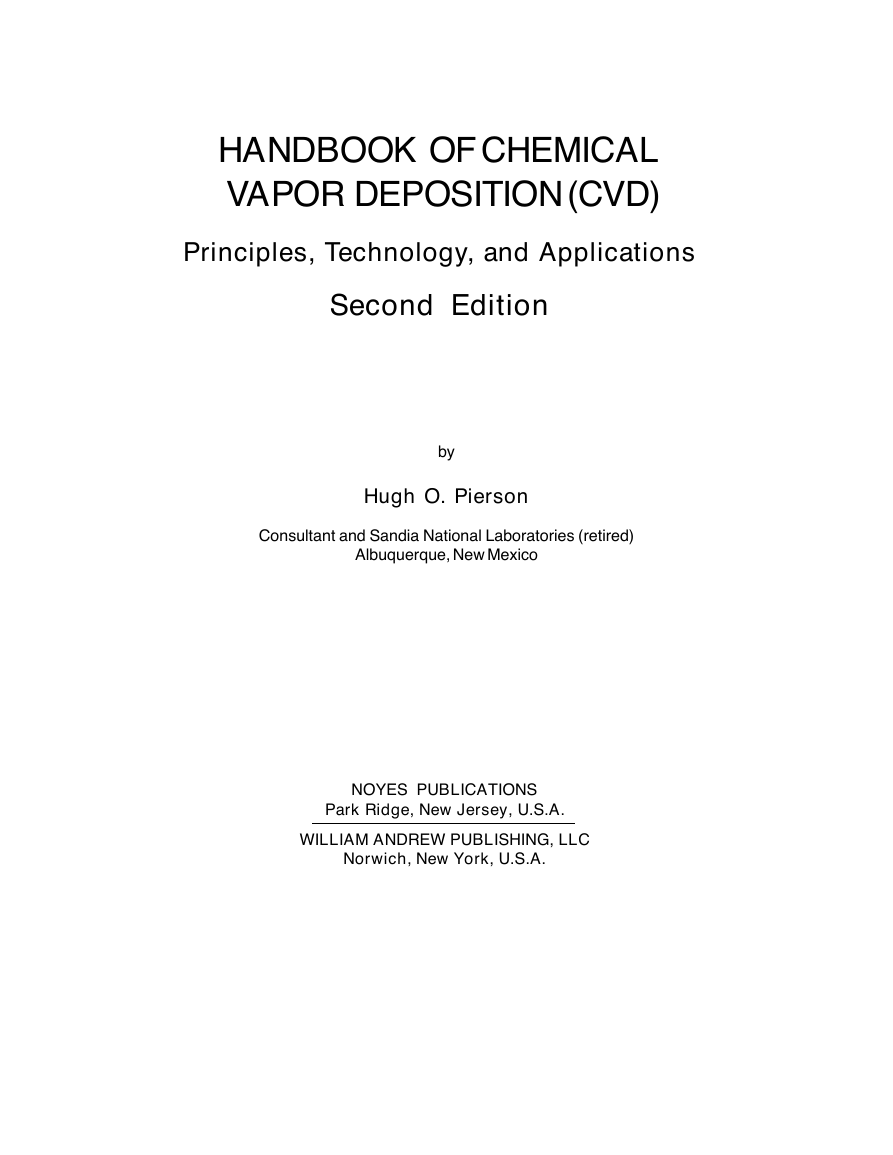
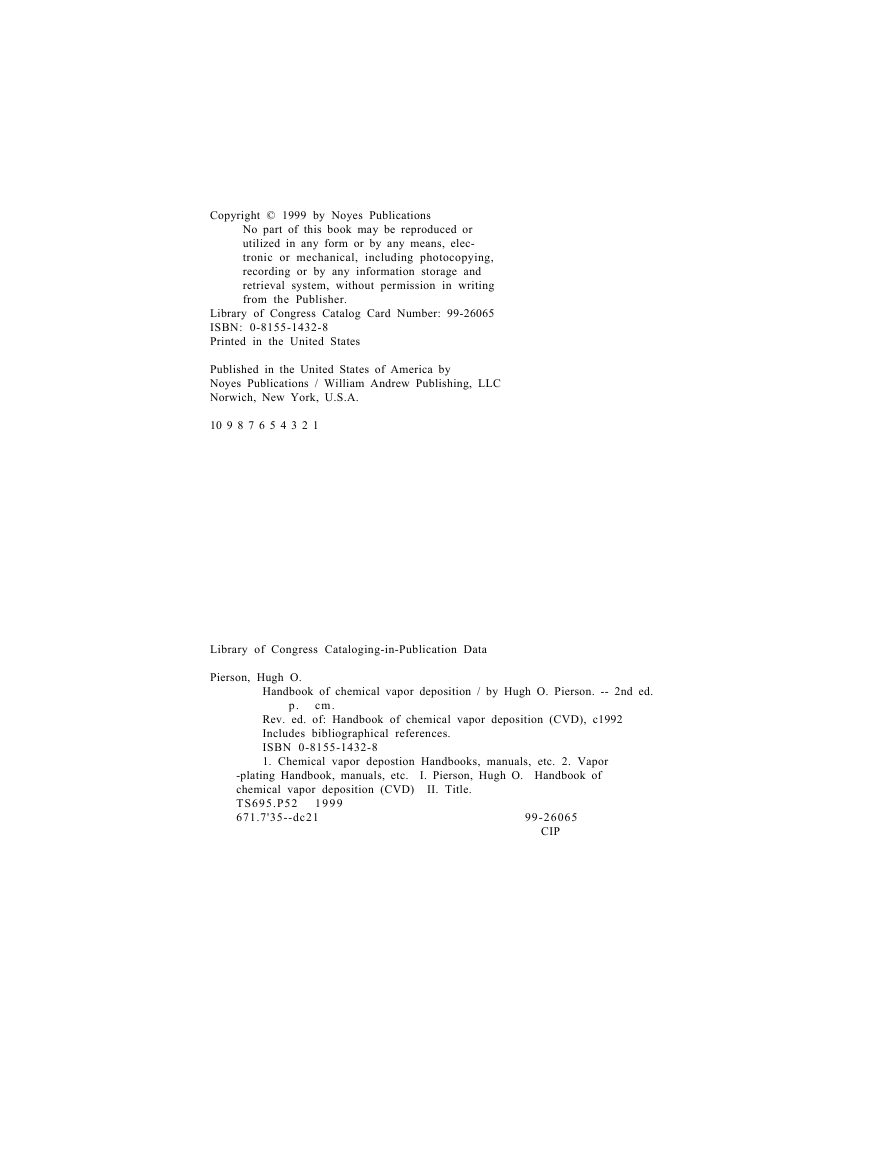
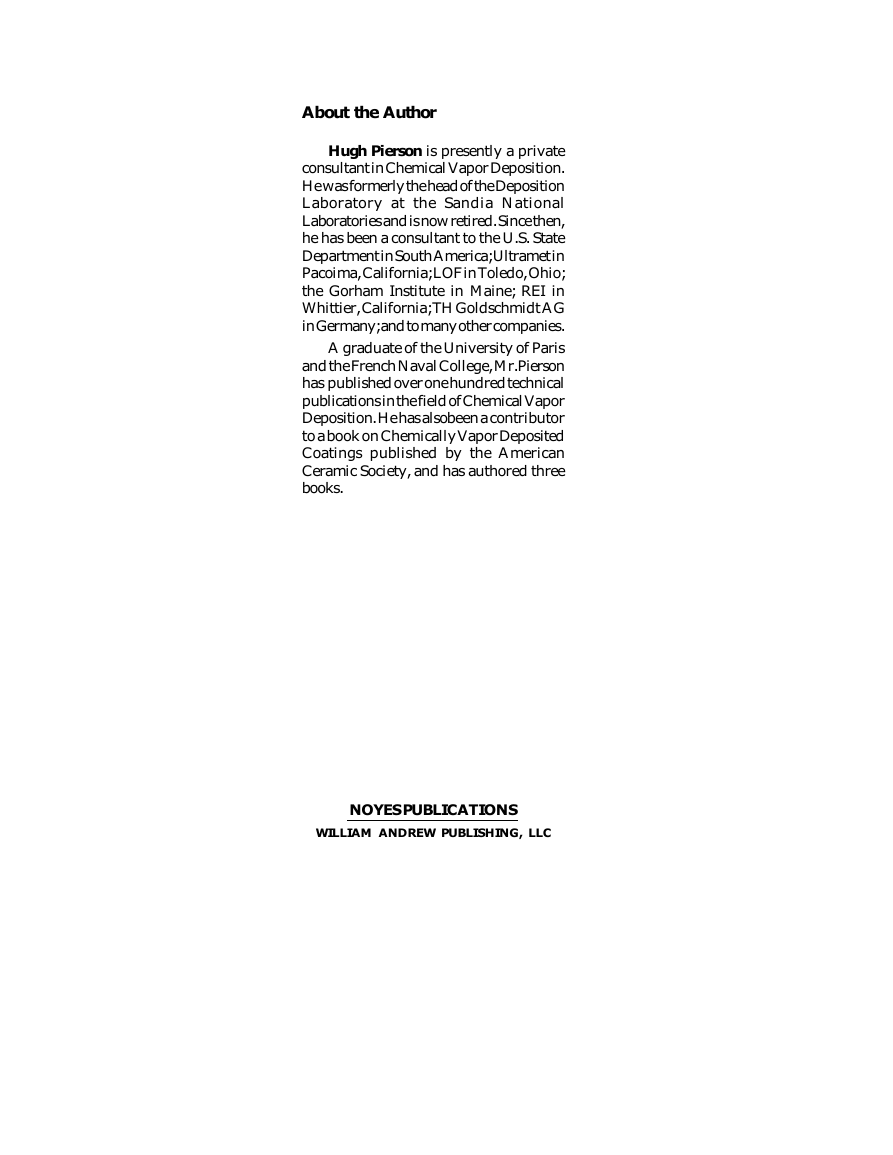
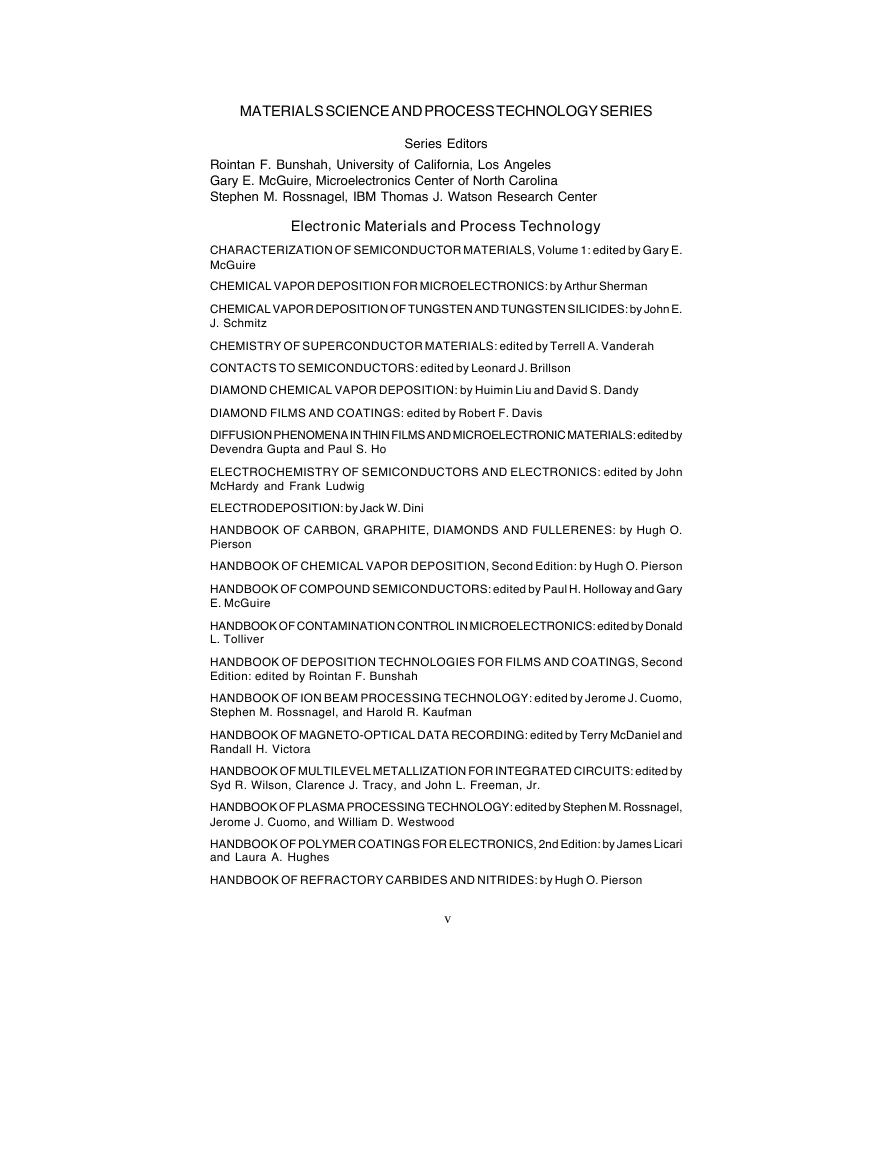


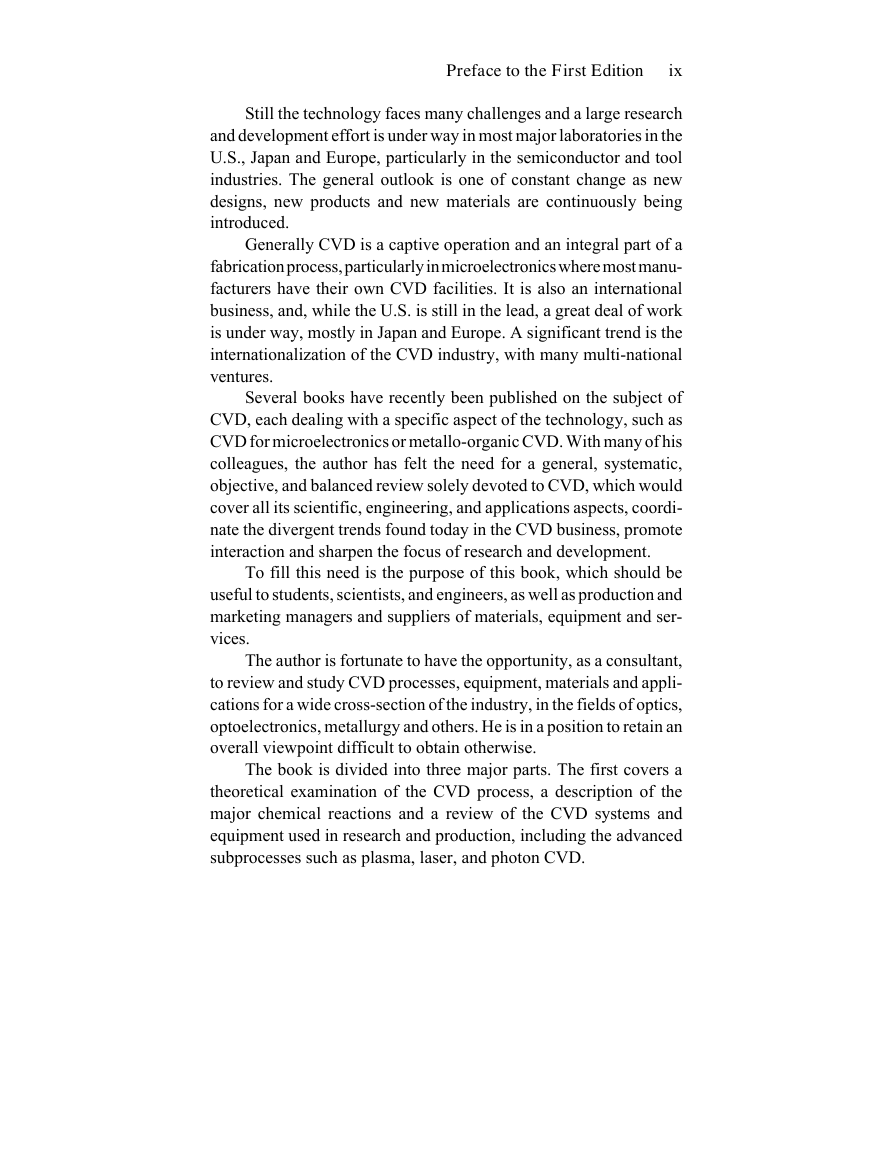
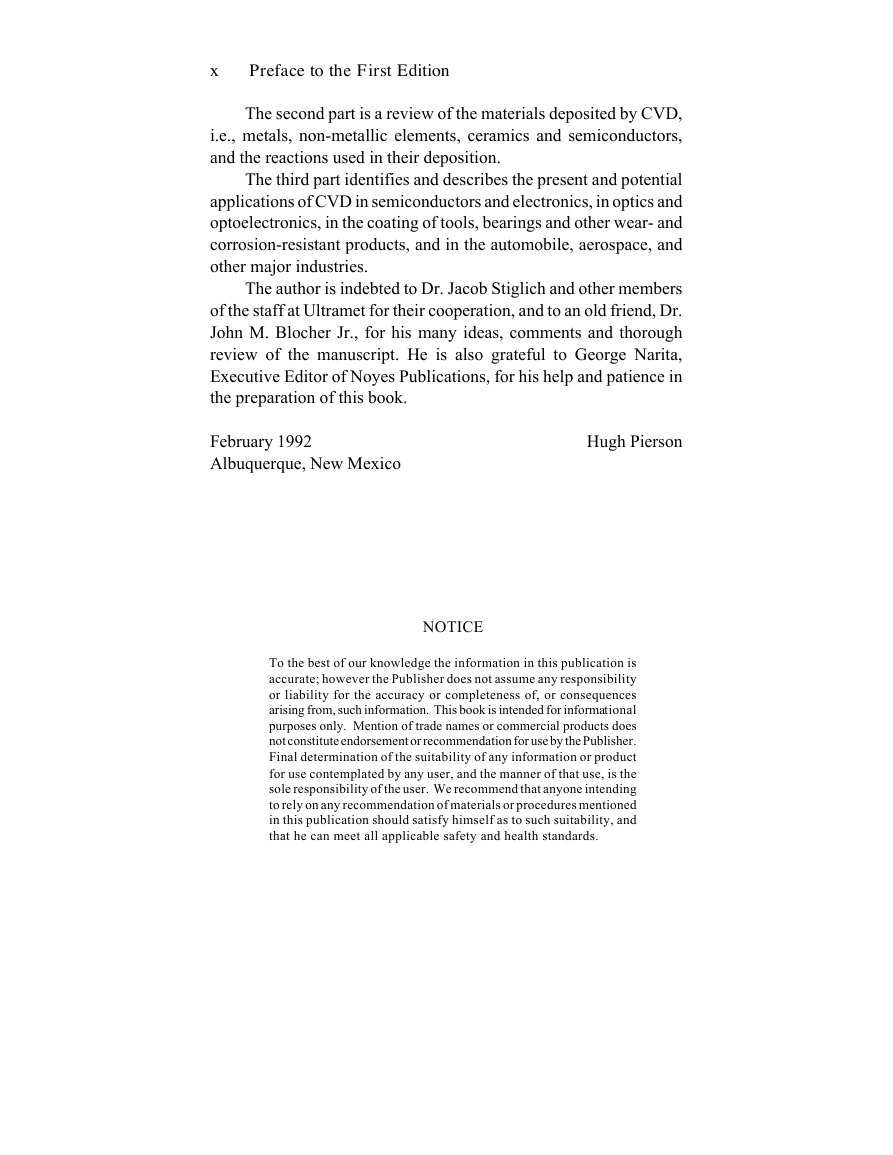








 2023年江西萍乡中考道德与法治真题及答案.doc
2023年江西萍乡中考道德与法治真题及答案.doc 2012年重庆南川中考生物真题及答案.doc
2012年重庆南川中考生物真题及答案.doc 2013年江西师范大学地理学综合及文艺理论基础考研真题.doc
2013年江西师范大学地理学综合及文艺理论基础考研真题.doc 2020年四川甘孜小升初语文真题及答案I卷.doc
2020年四川甘孜小升初语文真题及答案I卷.doc 2020年注册岩土工程师专业基础考试真题及答案.doc
2020年注册岩土工程师专业基础考试真题及答案.doc 2023-2024学年福建省厦门市九年级上学期数学月考试题及答案.doc
2023-2024学年福建省厦门市九年级上学期数学月考试题及答案.doc 2021-2022学年辽宁省沈阳市大东区九年级上学期语文期末试题及答案.doc
2021-2022学年辽宁省沈阳市大东区九年级上学期语文期末试题及答案.doc 2022-2023学年北京东城区初三第一学期物理期末试卷及答案.doc
2022-2023学年北京东城区初三第一学期物理期末试卷及答案.doc 2018上半年江西教师资格初中地理学科知识与教学能力真题及答案.doc
2018上半年江西教师资格初中地理学科知识与教学能力真题及答案.doc 2012年河北国家公务员申论考试真题及答案-省级.doc
2012年河北国家公务员申论考试真题及答案-省级.doc 2020-2021学年江苏省扬州市江都区邵樊片九年级上学期数学第一次质量检测试题及答案.doc
2020-2021学年江苏省扬州市江都区邵樊片九年级上学期数学第一次质量检测试题及答案.doc 2022下半年黑龙江教师资格证中学综合素质真题及答案.doc
2022下半年黑龙江教师资格证中学综合素质真题及答案.doc